Hospitality Consumer Behaviour, Decision-Making, and Marketing Report
VerifiedAdded on 2021/02/20
|10
|2865
|74
Report
AI Summary
This report provides a comprehensive overview of consumer behavior and decision-making processes within the hospitality industry. It explores the stages of the consumer decision-making journey, emphasizing the importance of mapping the path to purchase. The report highlights the key differences between B2B and B2C consumer behavior in hospitality, examines various market research approaches and methods, and evaluates factors influencing decision-making and buying behavior. Furthermore, it discusses how marketers respond to the decision-making process and influence each stage through relevant methods. The report covers topics such as need recognition, information search, open evaluation, purchasing decisions, and post-purchase evaluation. It also provides insights into the economic, passive, cognitive, and emotional views of consumer behavior, offering valuable information for understanding and improving marketing strategies within the hospitality sector. The report concludes with a summary of key findings and references.
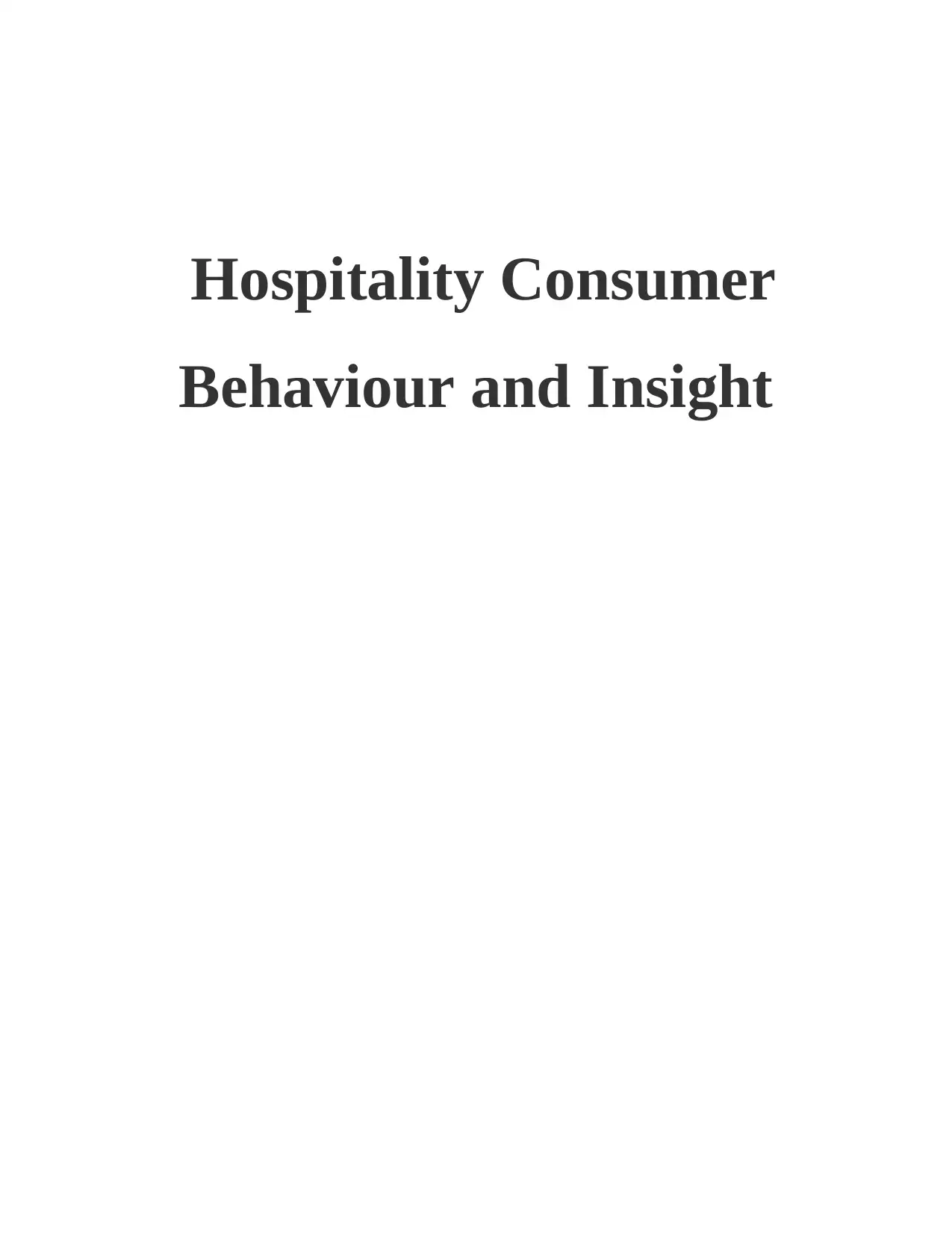
Hospitality Consumer
Behaviour and Insight
Behaviour and Insight
Paraphrase This Document
Need a fresh take? Get an instant paraphrase of this document with our AI Paraphraser
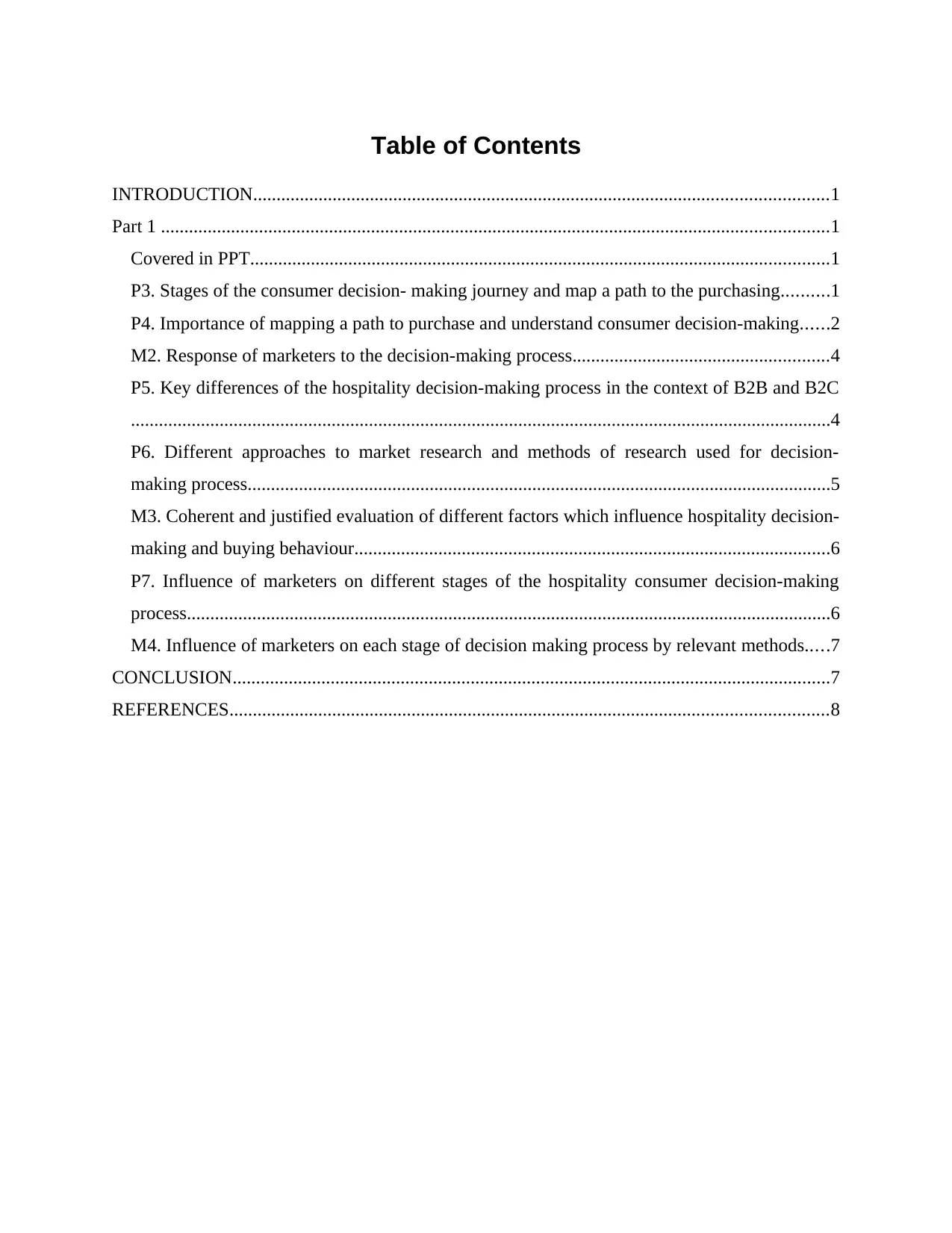
Table of Contents
INTRODUCTION...........................................................................................................................1
Part 1 ...............................................................................................................................................1
Covered in PPT............................................................................................................................1
P3. Stages of the consumer decision- making journey and map a path to the purchasing..........1
P4. Importance of mapping a path to purchase and understand consumer decision-making......2
M2. Response of marketers to the decision-making process.......................................................4
P5. Key differences of the hospitality decision-making process in the context of B2B and B2C
......................................................................................................................................................4
P6. Different approaches to market research and methods of research used for decision-
making process.............................................................................................................................5
M3. Coherent and justified evaluation of different factors which influence hospitality decision-
making and buying behaviour......................................................................................................6
P7. Influence of marketers on different stages of the hospitality consumer decision-making
process..........................................................................................................................................6
M4. Influence of marketers on each stage of decision making process by relevant methods.....7
CONCLUSION................................................................................................................................7
REFERENCES................................................................................................................................8
INTRODUCTION...........................................................................................................................1
Part 1 ...............................................................................................................................................1
Covered in PPT............................................................................................................................1
P3. Stages of the consumer decision- making journey and map a path to the purchasing..........1
P4. Importance of mapping a path to purchase and understand consumer decision-making......2
M2. Response of marketers to the decision-making process.......................................................4
P5. Key differences of the hospitality decision-making process in the context of B2B and B2C
......................................................................................................................................................4
P6. Different approaches to market research and methods of research used for decision-
making process.............................................................................................................................5
M3. Coherent and justified evaluation of different factors which influence hospitality decision-
making and buying behaviour......................................................................................................6
P7. Influence of marketers on different stages of the hospitality consumer decision-making
process..........................................................................................................................................6
M4. Influence of marketers on each stage of decision making process by relevant methods.....7
CONCLUSION................................................................................................................................7
REFERENCES................................................................................................................................8
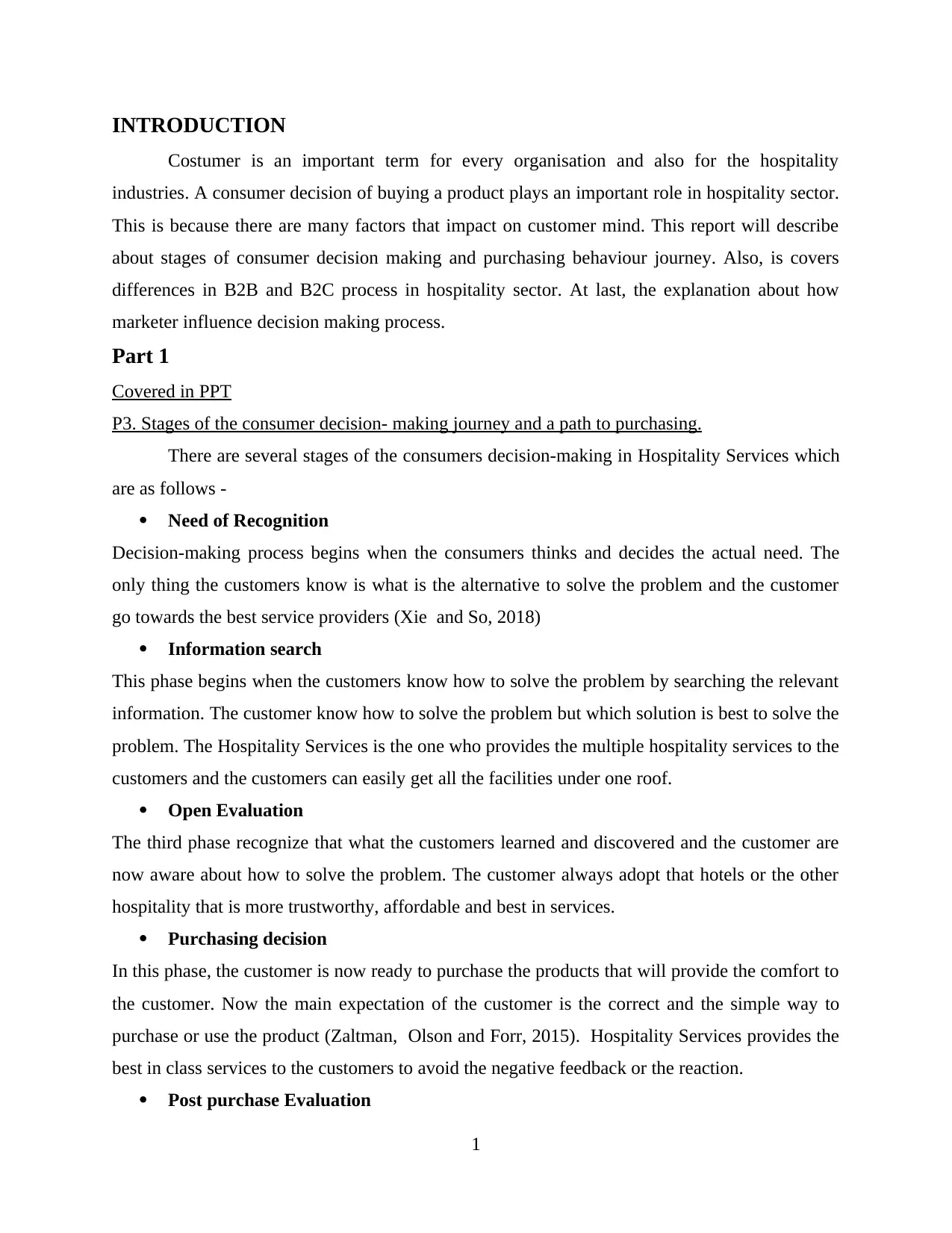
INTRODUCTION
Costumer is an important term for every organisation and also for the hospitality
industries. A consumer decision of buying a product plays an important role in hospitality sector.
This is because there are many factors that impact on customer mind. This report will describe
about stages of consumer decision making and purchasing behaviour journey. Also, is covers
differences in B2B and B2C process in hospitality sector. At last, the explanation about how
marketer influence decision making process.
Part 1
Covered in PPT
P3. Stages of the consumer decision- making journey and a path to purchasing.
There are several stages of the consumers decision-making in Hospitality Services which
are as follows -
Need of Recognition
Decision-making process begins when the consumers thinks and decides the actual need. The
only thing the customers know is what is the alternative to solve the problem and the customer
go towards the best service providers (Xie and So, 2018)
Information search
This phase begins when the customers know how to solve the problem by searching the relevant
information. The customer know how to solve the problem but which solution is best to solve the
problem. The Hospitality Services is the one who provides the multiple hospitality services to the
customers and the customers can easily get all the facilities under one roof.
Open Evaluation
The third phase recognize that what the customers learned and discovered and the customer are
now aware about how to solve the problem. The customer always adopt that hotels or the other
hospitality that is more trustworthy, affordable and best in services.
Purchasing decision
In this phase, the customer is now ready to purchase the products that will provide the comfort to
the customer. Now the main expectation of the customer is the correct and the simple way to
purchase or use the product (Zaltman, Olson and Forr, 2015). Hospitality Services provides the
best in class services to the customers to avoid the negative feedback or the reaction.
Post purchase Evaluation
1
Costumer is an important term for every organisation and also for the hospitality
industries. A consumer decision of buying a product plays an important role in hospitality sector.
This is because there are many factors that impact on customer mind. This report will describe
about stages of consumer decision making and purchasing behaviour journey. Also, is covers
differences in B2B and B2C process in hospitality sector. At last, the explanation about how
marketer influence decision making process.
Part 1
Covered in PPT
P3. Stages of the consumer decision- making journey and a path to purchasing.
There are several stages of the consumers decision-making in Hospitality Services which
are as follows -
Need of Recognition
Decision-making process begins when the consumers thinks and decides the actual need. The
only thing the customers know is what is the alternative to solve the problem and the customer
go towards the best service providers (Xie and So, 2018)
Information search
This phase begins when the customers know how to solve the problem by searching the relevant
information. The customer know how to solve the problem but which solution is best to solve the
problem. The Hospitality Services is the one who provides the multiple hospitality services to the
customers and the customers can easily get all the facilities under one roof.
Open Evaluation
The third phase recognize that what the customers learned and discovered and the customer are
now aware about how to solve the problem. The customer always adopt that hotels or the other
hospitality that is more trustworthy, affordable and best in services.
Purchasing decision
In this phase, the customer is now ready to purchase the products that will provide the comfort to
the customer. Now the main expectation of the customer is the correct and the simple way to
purchase or use the product (Zaltman, Olson and Forr, 2015). Hospitality Services provides the
best in class services to the customers to avoid the negative feedback or the reaction.
Post purchase Evaluation
1
⊘ This is a preview!⊘
Do you want full access?
Subscribe today to unlock all pages.

Trusted by 1+ million students worldwide
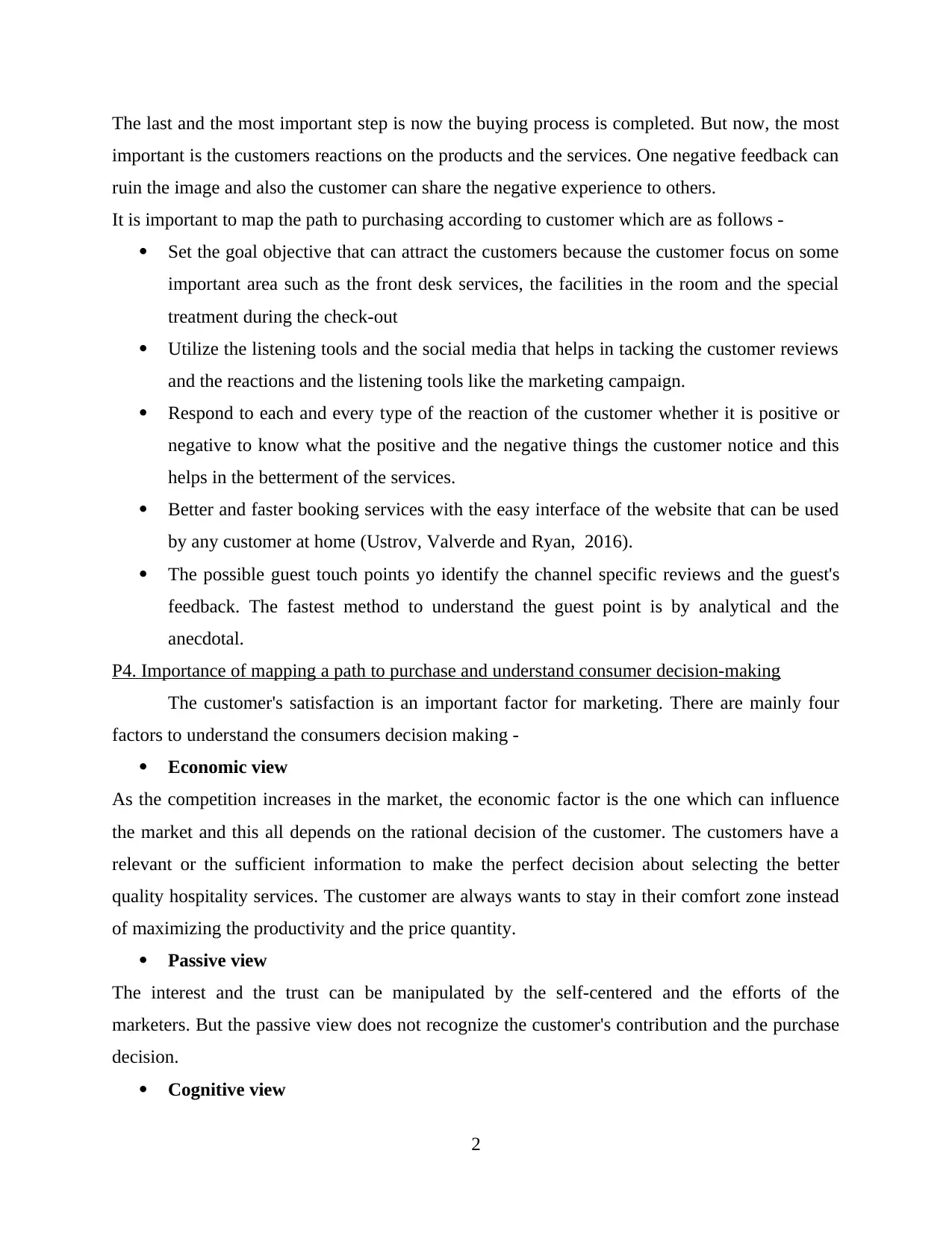
The last and the most important step is now the buying process is completed. But now, the most
important is the customers reactions on the products and the services. One negative feedback can
ruin the image and also the customer can share the negative experience to others.
It is important to map the path to purchasing according to customer which are as follows -
Set the goal objective that can attract the customers because the customer focus on some
important area such as the front desk services, the facilities in the room and the special
treatment during the check-out
Utilize the listening tools and the social media that helps in tacking the customer reviews
and the reactions and the listening tools like the marketing campaign.
Respond to each and every type of the reaction of the customer whether it is positive or
negative to know what the positive and the negative things the customer notice and this
helps in the betterment of the services.
Better and faster booking services with the easy interface of the website that can be used
by any customer at home (Ustrov, Valverde and Ryan, 2016).
The possible guest touch points yo identify the channel specific reviews and the guest's
feedback. The fastest method to understand the guest point is by analytical and the
anecdotal.
P4. Importance of mapping a path to purchase and understand consumer decision-making
The customer's satisfaction is an important factor for marketing. There are mainly four
factors to understand the consumers decision making -
Economic view
As the competition increases in the market, the economic factor is the one which can influence
the market and this all depends on the rational decision of the customer. The customers have a
relevant or the sufficient information to make the perfect decision about selecting the better
quality hospitality services. The customer are always wants to stay in their comfort zone instead
of maximizing the productivity and the price quantity.
Passive view
The interest and the trust can be manipulated by the self-centered and the efforts of the
marketers. But the passive view does not recognize the customer's contribution and the purchase
decision.
Cognitive view
2
important is the customers reactions on the products and the services. One negative feedback can
ruin the image and also the customer can share the negative experience to others.
It is important to map the path to purchasing according to customer which are as follows -
Set the goal objective that can attract the customers because the customer focus on some
important area such as the front desk services, the facilities in the room and the special
treatment during the check-out
Utilize the listening tools and the social media that helps in tacking the customer reviews
and the reactions and the listening tools like the marketing campaign.
Respond to each and every type of the reaction of the customer whether it is positive or
negative to know what the positive and the negative things the customer notice and this
helps in the betterment of the services.
Better and faster booking services with the easy interface of the website that can be used
by any customer at home (Ustrov, Valverde and Ryan, 2016).
The possible guest touch points yo identify the channel specific reviews and the guest's
feedback. The fastest method to understand the guest point is by analytical and the
anecdotal.
P4. Importance of mapping a path to purchase and understand consumer decision-making
The customer's satisfaction is an important factor for marketing. There are mainly four
factors to understand the consumers decision making -
Economic view
As the competition increases in the market, the economic factor is the one which can influence
the market and this all depends on the rational decision of the customer. The customers have a
relevant or the sufficient information to make the perfect decision about selecting the better
quality hospitality services. The customer are always wants to stay in their comfort zone instead
of maximizing the productivity and the price quantity.
Passive view
The interest and the trust can be manipulated by the self-centered and the efforts of the
marketers. But the passive view does not recognize the customer's contribution and the purchase
decision.
Cognitive view
2
Paraphrase This Document
Need a fresh take? Get an instant paraphrase of this document with our AI Paraphraser
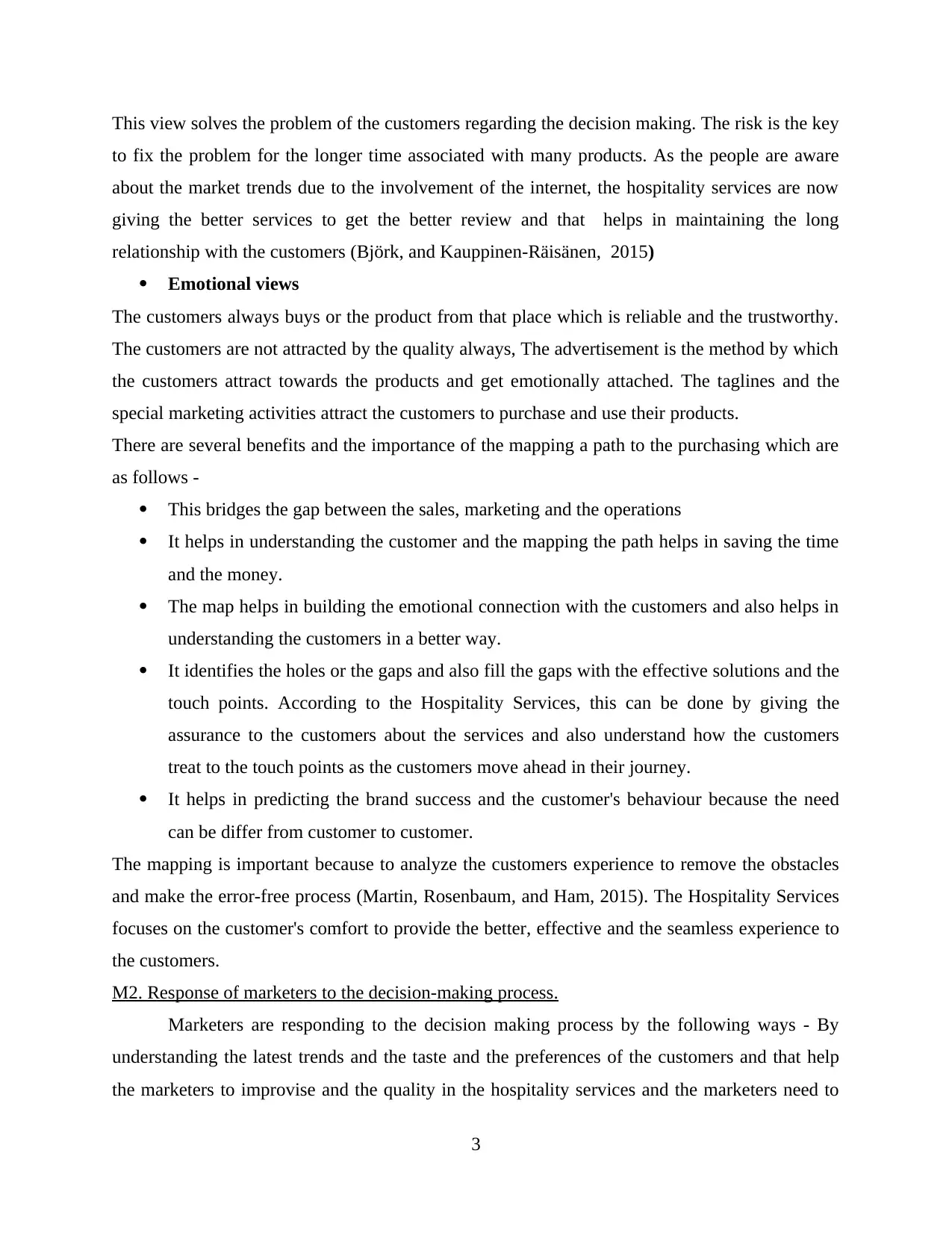
This view solves the problem of the customers regarding the decision making. The risk is the key
to fix the problem for the longer time associated with many products. As the people are aware
about the market trends due to the involvement of the internet, the hospitality services are now
giving the better services to get the better review and that helps in maintaining the long
relationship with the customers (Björk, and Kauppinen-Räisänen, 2015)
Emotional views
The customers always buys or the product from that place which is reliable and the trustworthy.
The customers are not attracted by the quality always, The advertisement is the method by which
the customers attract towards the products and get emotionally attached. The taglines and the
special marketing activities attract the customers to purchase and use their products.
There are several benefits and the importance of the mapping a path to the purchasing which are
as follows -
This bridges the gap between the sales, marketing and the operations
It helps in understanding the customer and the mapping the path helps in saving the time
and the money.
The map helps in building the emotional connection with the customers and also helps in
understanding the customers in a better way.
It identifies the holes or the gaps and also fill the gaps with the effective solutions and the
touch points. According to the Hospitality Services, this can be done by giving the
assurance to the customers about the services and also understand how the customers
treat to the touch points as the customers move ahead in their journey.
It helps in predicting the brand success and the customer's behaviour because the need
can be differ from customer to customer.
The mapping is important because to analyze the customers experience to remove the obstacles
and make the error-free process (Martin, Rosenbaum, and Ham, 2015). The Hospitality Services
focuses on the customer's comfort to provide the better, effective and the seamless experience to
the customers.
M2. Response of marketers to the decision-making process.
Marketers are responding to the decision making process by the following ways - By
understanding the latest trends and the taste and the preferences of the customers and that help
the marketers to improvise and the quality in the hospitality services and the marketers need to
3
to fix the problem for the longer time associated with many products. As the people are aware
about the market trends due to the involvement of the internet, the hospitality services are now
giving the better services to get the better review and that helps in maintaining the long
relationship with the customers (Björk, and Kauppinen-Räisänen, 2015)
Emotional views
The customers always buys or the product from that place which is reliable and the trustworthy.
The customers are not attracted by the quality always, The advertisement is the method by which
the customers attract towards the products and get emotionally attached. The taglines and the
special marketing activities attract the customers to purchase and use their products.
There are several benefits and the importance of the mapping a path to the purchasing which are
as follows -
This bridges the gap between the sales, marketing and the operations
It helps in understanding the customer and the mapping the path helps in saving the time
and the money.
The map helps in building the emotional connection with the customers and also helps in
understanding the customers in a better way.
It identifies the holes or the gaps and also fill the gaps with the effective solutions and the
touch points. According to the Hospitality Services, this can be done by giving the
assurance to the customers about the services and also understand how the customers
treat to the touch points as the customers move ahead in their journey.
It helps in predicting the brand success and the customer's behaviour because the need
can be differ from customer to customer.
The mapping is important because to analyze the customers experience to remove the obstacles
and make the error-free process (Martin, Rosenbaum, and Ham, 2015). The Hospitality Services
focuses on the customer's comfort to provide the better, effective and the seamless experience to
the customers.
M2. Response of marketers to the decision-making process.
Marketers are responding to the decision making process by the following ways - By
understanding the latest trends and the taste and the preferences of the customers and that help
the marketers to improvise and the quality in the hospitality services and the marketers need to
3
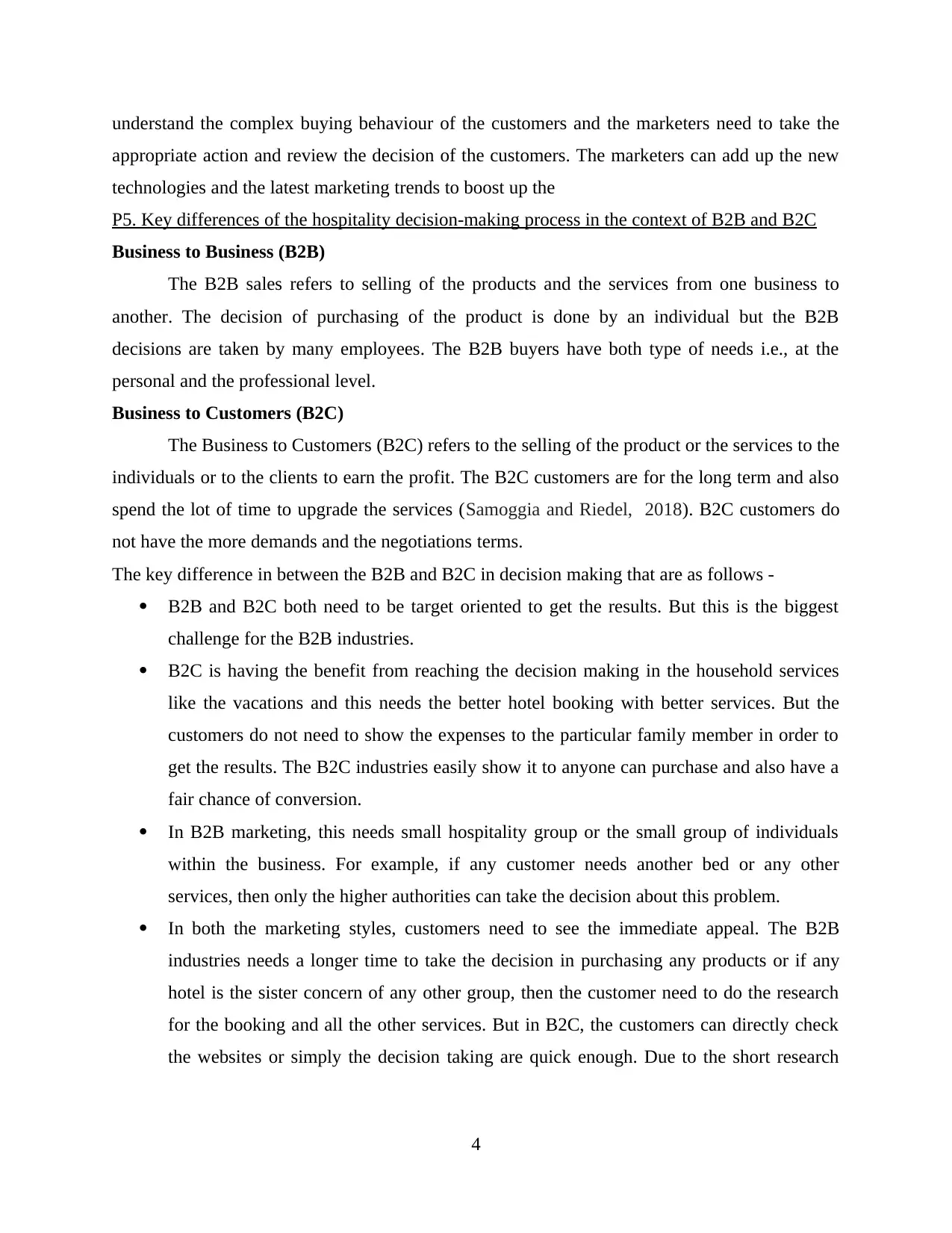
understand the complex buying behaviour of the customers and the marketers need to take the
appropriate action and review the decision of the customers. The marketers can add up the new
technologies and the latest marketing trends to boost up the
P5. Key differences of the hospitality decision-making process in the context of B2B and B2C
Business to Business (B2B)
The B2B sales refers to selling of the products and the services from one business to
another. The decision of purchasing of the product is done by an individual but the B2B
decisions are taken by many employees. The B2B buyers have both type of needs i.e., at the
personal and the professional level.
Business to Customers (B2C)
The Business to Customers (B2C) refers to the selling of the product or the services to the
individuals or to the clients to earn the profit. The B2C customers are for the long term and also
spend the lot of time to upgrade the services (Samoggia and Riedel, 2018). B2C customers do
not have the more demands and the negotiations terms.
The key difference in between the B2B and B2C in decision making that are as follows -
B2B and B2C both need to be target oriented to get the results. But this is the biggest
challenge for the B2B industries.
B2C is having the benefit from reaching the decision making in the household services
like the vacations and this needs the better hotel booking with better services. But the
customers do not need to show the expenses to the particular family member in order to
get the results. The B2C industries easily show it to anyone can purchase and also have a
fair chance of conversion.
In B2B marketing, this needs small hospitality group or the small group of individuals
within the business. For example, if any customer needs another bed or any other
services, then only the higher authorities can take the decision about this problem.
In both the marketing styles, customers need to see the immediate appeal. The B2B
industries needs a longer time to take the decision in purchasing any products or if any
hotel is the sister concern of any other group, then the customer need to do the research
for the booking and all the other services. But in B2C, the customers can directly check
the websites or simply the decision taking are quick enough. Due to the short research
4
appropriate action and review the decision of the customers. The marketers can add up the new
technologies and the latest marketing trends to boost up the
P5. Key differences of the hospitality decision-making process in the context of B2B and B2C
Business to Business (B2B)
The B2B sales refers to selling of the products and the services from one business to
another. The decision of purchasing of the product is done by an individual but the B2B
decisions are taken by many employees. The B2B buyers have both type of needs i.e., at the
personal and the professional level.
Business to Customers (B2C)
The Business to Customers (B2C) refers to the selling of the product or the services to the
individuals or to the clients to earn the profit. The B2C customers are for the long term and also
spend the lot of time to upgrade the services (Samoggia and Riedel, 2018). B2C customers do
not have the more demands and the negotiations terms.
The key difference in between the B2B and B2C in decision making that are as follows -
B2B and B2C both need to be target oriented to get the results. But this is the biggest
challenge for the B2B industries.
B2C is having the benefit from reaching the decision making in the household services
like the vacations and this needs the better hotel booking with better services. But the
customers do not need to show the expenses to the particular family member in order to
get the results. The B2C industries easily show it to anyone can purchase and also have a
fair chance of conversion.
In B2B marketing, this needs small hospitality group or the small group of individuals
within the business. For example, if any customer needs another bed or any other
services, then only the higher authorities can take the decision about this problem.
In both the marketing styles, customers need to see the immediate appeal. The B2B
industries needs a longer time to take the decision in purchasing any products or if any
hotel is the sister concern of any other group, then the customer need to do the research
for the booking and all the other services. But in B2C, the customers can directly check
the websites or simply the decision taking are quick enough. Due to the short research
4
⊘ This is a preview!⊘
Do you want full access?
Subscribe today to unlock all pages.

Trusted by 1+ million students worldwide
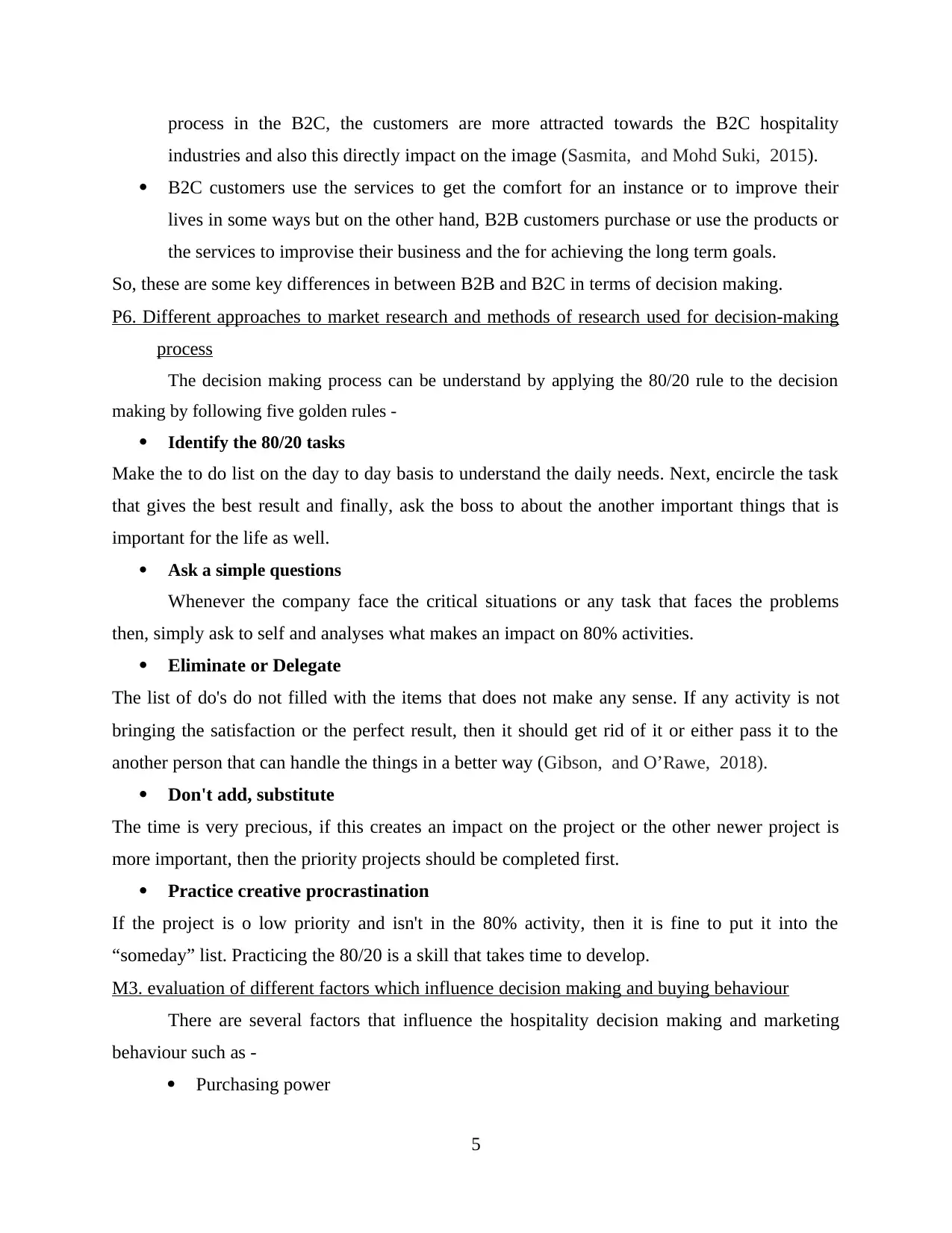
process in the B2C, the customers are more attracted towards the B2C hospitality
industries and also this directly impact on the image (Sasmita, and Mohd Suki, 2015).
B2C customers use the services to get the comfort for an instance or to improve their
lives in some ways but on the other hand, B2B customers purchase or use the products or
the services to improvise their business and the for achieving the long term goals.
So, these are some key differences in between B2B and B2C in terms of decision making.
P6. Different approaches to market research and methods of research used for decision-making
process
The decision making process can be understand by applying the 80/20 rule to the decision
making by following five golden rules -
Identify the 80/20 tasks
Make the to do list on the day to day basis to understand the daily needs. Next, encircle the task
that gives the best result and finally, ask the boss to about the another important things that is
important for the life as well.
Ask a simple questions
Whenever the company face the critical situations or any task that faces the problems
then, simply ask to self and analyses what makes an impact on 80% activities.
Eliminate or Delegate
The list of do's do not filled with the items that does not make any sense. If any activity is not
bringing the satisfaction or the perfect result, then it should get rid of it or either pass it to the
another person that can handle the things in a better way (Gibson, and O’Rawe, 2018).
Don't add, substitute
The time is very precious, if this creates an impact on the project or the other newer project is
more important, then the priority projects should be completed first.
Practice creative procrastination
If the project is o low priority and isn't in the 80% activity, then it is fine to put it into the
“someday” list. Practicing the 80/20 is a skill that takes time to develop.
M3. evaluation of different factors which influence decision making and buying behaviour
There are several factors that influence the hospitality decision making and marketing
behaviour such as -
Purchasing power
5
industries and also this directly impact on the image (Sasmita, and Mohd Suki, 2015).
B2C customers use the services to get the comfort for an instance or to improve their
lives in some ways but on the other hand, B2B customers purchase or use the products or
the services to improvise their business and the for achieving the long term goals.
So, these are some key differences in between B2B and B2C in terms of decision making.
P6. Different approaches to market research and methods of research used for decision-making
process
The decision making process can be understand by applying the 80/20 rule to the decision
making by following five golden rules -
Identify the 80/20 tasks
Make the to do list on the day to day basis to understand the daily needs. Next, encircle the task
that gives the best result and finally, ask the boss to about the another important things that is
important for the life as well.
Ask a simple questions
Whenever the company face the critical situations or any task that faces the problems
then, simply ask to self and analyses what makes an impact on 80% activities.
Eliminate or Delegate
The list of do's do not filled with the items that does not make any sense. If any activity is not
bringing the satisfaction or the perfect result, then it should get rid of it or either pass it to the
another person that can handle the things in a better way (Gibson, and O’Rawe, 2018).
Don't add, substitute
The time is very precious, if this creates an impact on the project or the other newer project is
more important, then the priority projects should be completed first.
Practice creative procrastination
If the project is o low priority and isn't in the 80% activity, then it is fine to put it into the
“someday” list. Practicing the 80/20 is a skill that takes time to develop.
M3. evaluation of different factors which influence decision making and buying behaviour
There are several factors that influence the hospitality decision making and marketing
behaviour such as -
Purchasing power
5
Paraphrase This Document
Need a fresh take? Get an instant paraphrase of this document with our AI Paraphraser
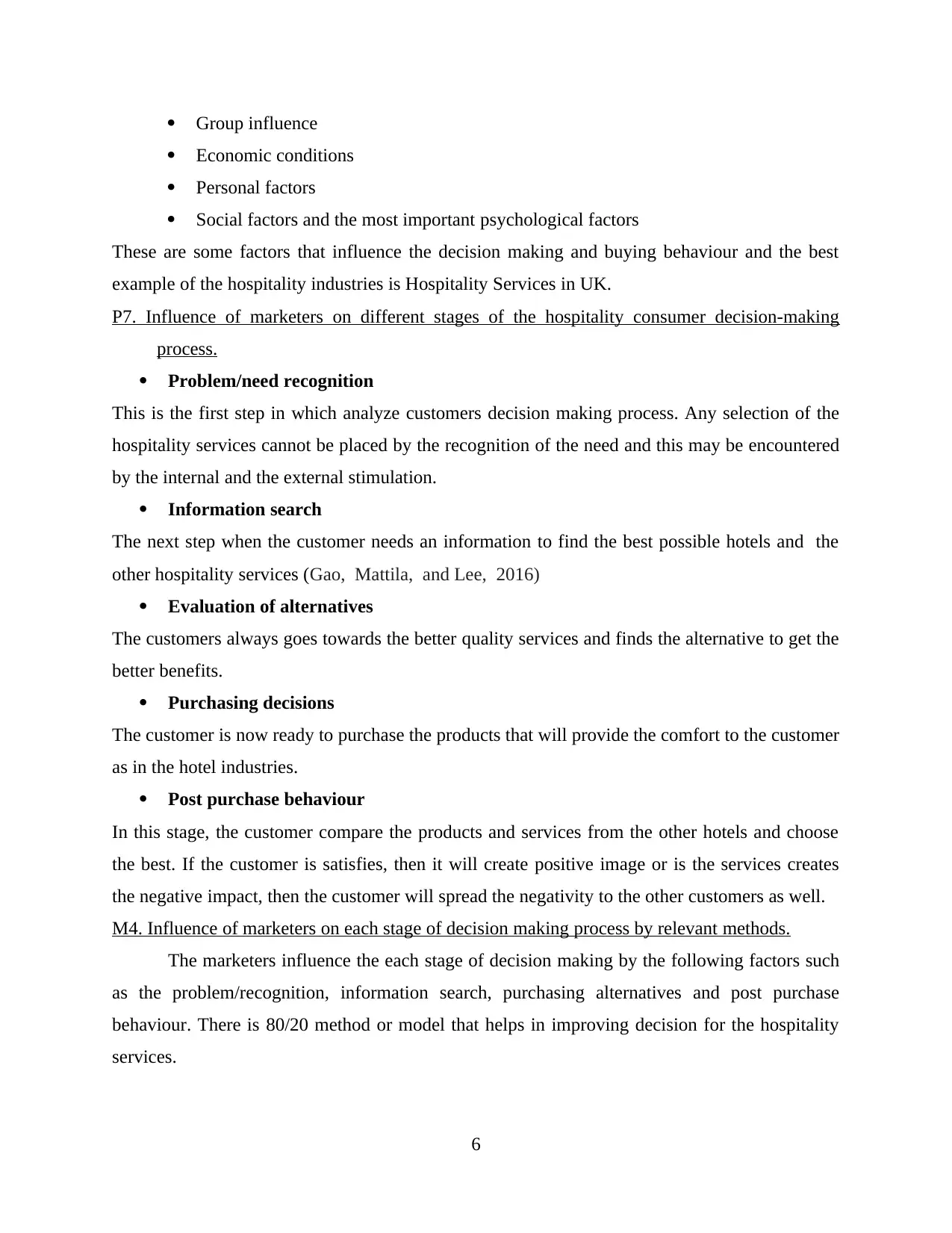
Group influence
Economic conditions
Personal factors
Social factors and the most important psychological factors
These are some factors that influence the decision making and buying behaviour and the best
example of the hospitality industries is Hospitality Services in UK.
P7. Influence of marketers on different stages of the hospitality consumer decision-making
process.
Problem/need recognition
This is the first step in which analyze customers decision making process. Any selection of the
hospitality services cannot be placed by the recognition of the need and this may be encountered
by the internal and the external stimulation.
Information search
The next step when the customer needs an information to find the best possible hotels and the
other hospitality services (Gao, Mattila, and Lee, 2016)
Evaluation of alternatives
The customers always goes towards the better quality services and finds the alternative to get the
better benefits.
Purchasing decisions
The customer is now ready to purchase the products that will provide the comfort to the customer
as in the hotel industries.
Post purchase behaviour
In this stage, the customer compare the products and services from the other hotels and choose
the best. If the customer is satisfies, then it will create positive image or is the services creates
the negative impact, then the customer will spread the negativity to the other customers as well.
M4. Influence of marketers on each stage of decision making process by relevant methods.
The marketers influence the each stage of decision making by the following factors such
as the problem/recognition, information search, purchasing alternatives and post purchase
behaviour. There is 80/20 method or model that helps in improving decision for the hospitality
services.
6
Economic conditions
Personal factors
Social factors and the most important psychological factors
These are some factors that influence the decision making and buying behaviour and the best
example of the hospitality industries is Hospitality Services in UK.
P7. Influence of marketers on different stages of the hospitality consumer decision-making
process.
Problem/need recognition
This is the first step in which analyze customers decision making process. Any selection of the
hospitality services cannot be placed by the recognition of the need and this may be encountered
by the internal and the external stimulation.
Information search
The next step when the customer needs an information to find the best possible hotels and the
other hospitality services (Gao, Mattila, and Lee, 2016)
Evaluation of alternatives
The customers always goes towards the better quality services and finds the alternative to get the
better benefits.
Purchasing decisions
The customer is now ready to purchase the products that will provide the comfort to the customer
as in the hotel industries.
Post purchase behaviour
In this stage, the customer compare the products and services from the other hotels and choose
the best. If the customer is satisfies, then it will create positive image or is the services creates
the negative impact, then the customer will spread the negativity to the other customers as well.
M4. Influence of marketers on each stage of decision making process by relevant methods.
The marketers influence the each stage of decision making by the following factors such
as the problem/recognition, information search, purchasing alternatives and post purchase
behaviour. There is 80/20 method or model that helps in improving decision for the hospitality
services.
6
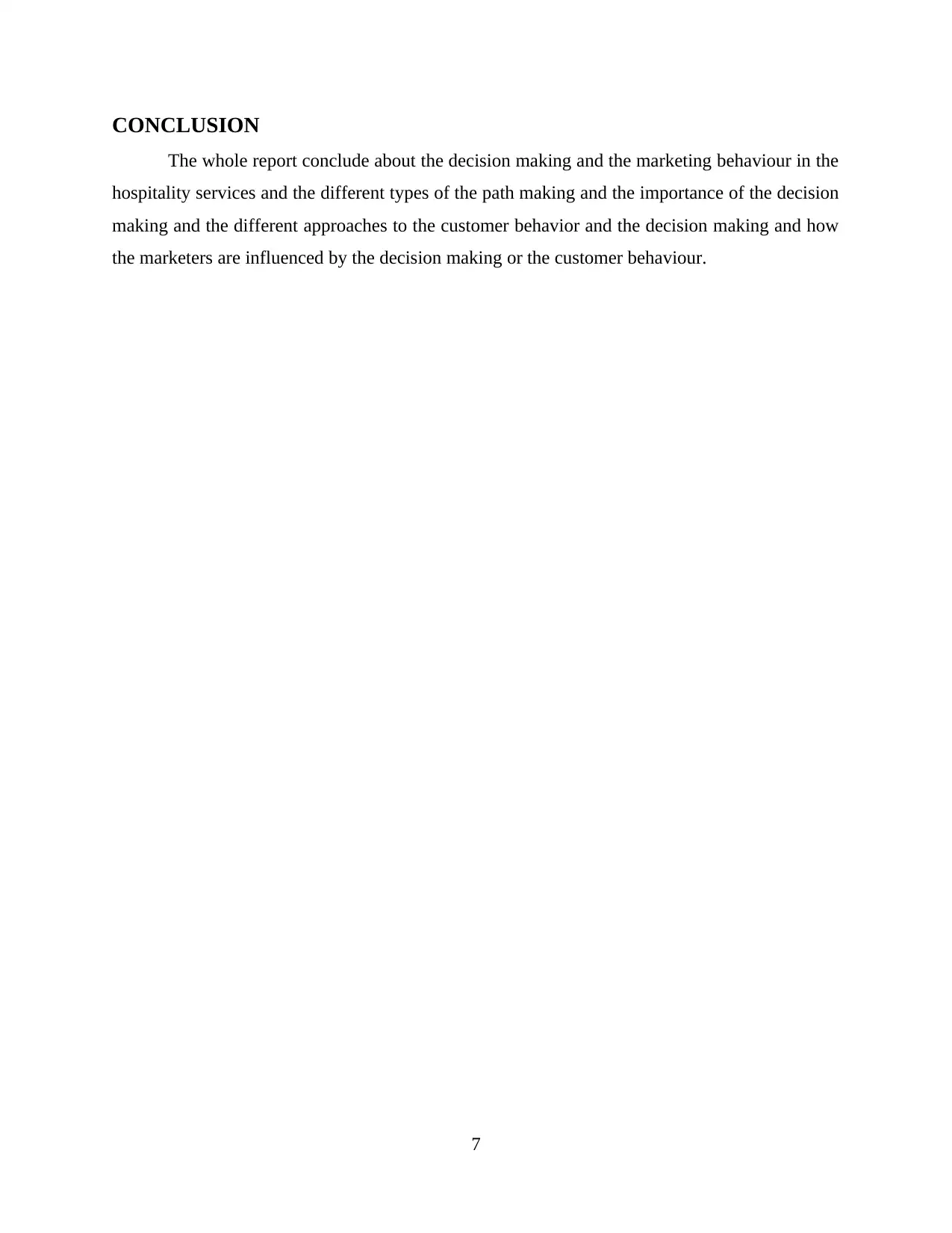
CONCLUSION
The whole report conclude about the decision making and the marketing behaviour in the
hospitality services and the different types of the path making and the importance of the decision
making and the different approaches to the customer behavior and the decision making and how
the marketers are influenced by the decision making or the customer behaviour.
7
The whole report conclude about the decision making and the marketing behaviour in the
hospitality services and the different types of the path making and the importance of the decision
making and the different approaches to the customer behavior and the decision making and how
the marketers are influenced by the decision making or the customer behaviour.
7
⊘ This is a preview!⊘
Do you want full access?
Subscribe today to unlock all pages.

Trusted by 1+ million students worldwide
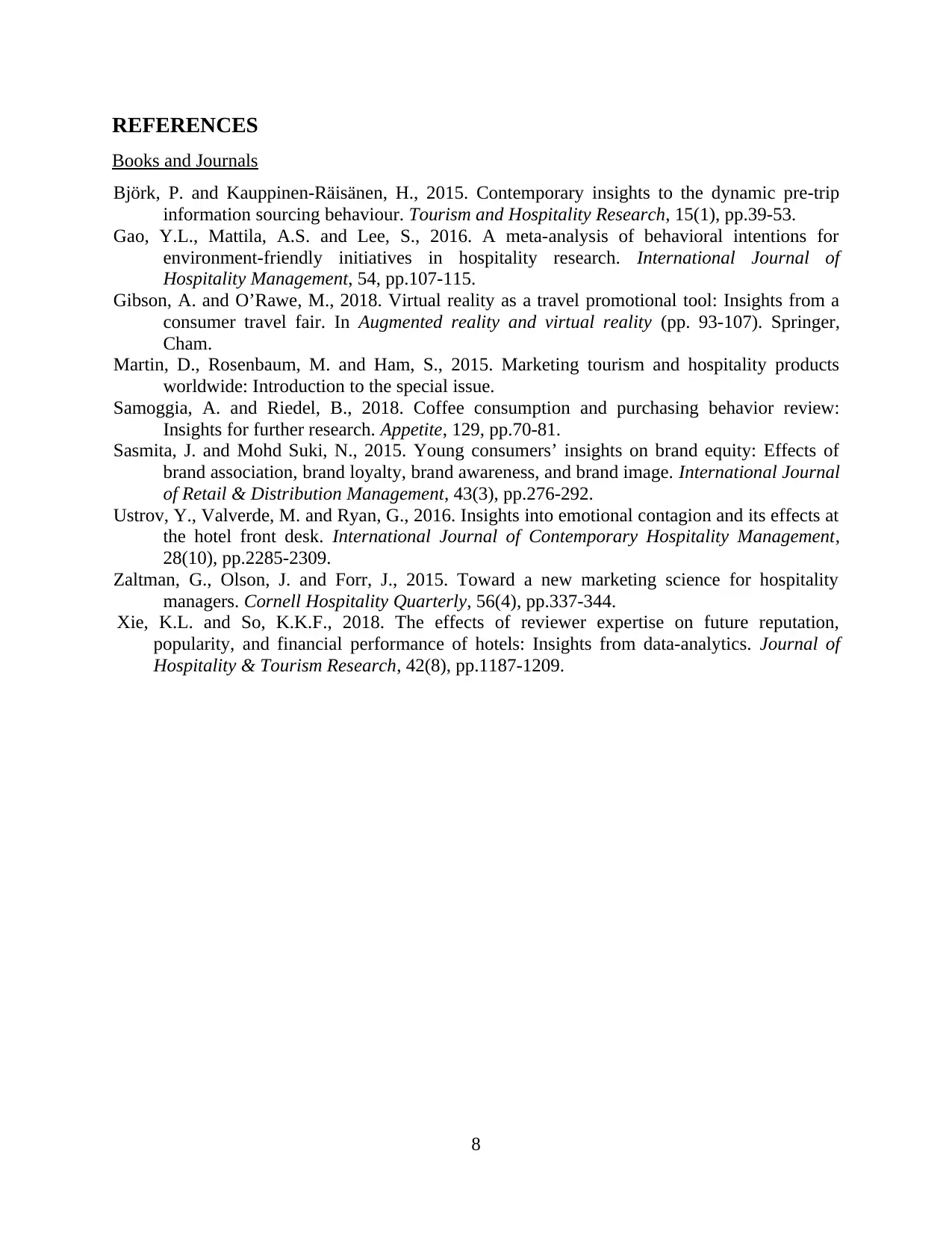
REFERENCES
Books and Journals
Björk, P. and Kauppinen-Räisänen, H., 2015. Contemporary insights to the dynamic pre-trip
information sourcing behaviour. Tourism and Hospitality Research, 15(1), pp.39-53.
Gao, Y.L., Mattila, A.S. and Lee, S., 2016. A meta-analysis of behavioral intentions for
environment-friendly initiatives in hospitality research. International Journal of
Hospitality Management, 54, pp.107-115.
Gibson, A. and O’Rawe, M., 2018. Virtual reality as a travel promotional tool: Insights from a
consumer travel fair. In Augmented reality and virtual reality (pp. 93-107). Springer,
Cham.
Martin, D., Rosenbaum, M. and Ham, S., 2015. Marketing tourism and hospitality products
worldwide: Introduction to the special issue.
Samoggia, A. and Riedel, B., 2018. Coffee consumption and purchasing behavior review:
Insights for further research. Appetite, 129, pp.70-81.
Sasmita, J. and Mohd Suki, N., 2015. Young consumers’ insights on brand equity: Effects of
brand association, brand loyalty, brand awareness, and brand image. International Journal
of Retail & Distribution Management, 43(3), pp.276-292.
Ustrov, Y., Valverde, M. and Ryan, G., 2016. Insights into emotional contagion and its effects at
the hotel front desk. International Journal of Contemporary Hospitality Management,
28(10), pp.2285-2309.
Zaltman, G., Olson, J. and Forr, J., 2015. Toward a new marketing science for hospitality
managers. Cornell Hospitality Quarterly, 56(4), pp.337-344.
Xie, K.L. and So, K.K.F., 2018. The effects of reviewer expertise on future reputation,
popularity, and financial performance of hotels: Insights from data-analytics. Journal of
Hospitality & Tourism Research, 42(8), pp.1187-1209.
8
Books and Journals
Björk, P. and Kauppinen-Räisänen, H., 2015. Contemporary insights to the dynamic pre-trip
information sourcing behaviour. Tourism and Hospitality Research, 15(1), pp.39-53.
Gao, Y.L., Mattila, A.S. and Lee, S., 2016. A meta-analysis of behavioral intentions for
environment-friendly initiatives in hospitality research. International Journal of
Hospitality Management, 54, pp.107-115.
Gibson, A. and O’Rawe, M., 2018. Virtual reality as a travel promotional tool: Insights from a
consumer travel fair. In Augmented reality and virtual reality (pp. 93-107). Springer,
Cham.
Martin, D., Rosenbaum, M. and Ham, S., 2015. Marketing tourism and hospitality products
worldwide: Introduction to the special issue.
Samoggia, A. and Riedel, B., 2018. Coffee consumption and purchasing behavior review:
Insights for further research. Appetite, 129, pp.70-81.
Sasmita, J. and Mohd Suki, N., 2015. Young consumers’ insights on brand equity: Effects of
brand association, brand loyalty, brand awareness, and brand image. International Journal
of Retail & Distribution Management, 43(3), pp.276-292.
Ustrov, Y., Valverde, M. and Ryan, G., 2016. Insights into emotional contagion and its effects at
the hotel front desk. International Journal of Contemporary Hospitality Management,
28(10), pp.2285-2309.
Zaltman, G., Olson, J. and Forr, J., 2015. Toward a new marketing science for hospitality
managers. Cornell Hospitality Quarterly, 56(4), pp.337-344.
Xie, K.L. and So, K.K.F., 2018. The effects of reviewer expertise on future reputation,
popularity, and financial performance of hotels: Insights from data-analytics. Journal of
Hospitality & Tourism Research, 42(8), pp.1187-1209.
8
1 out of 10
Related Documents
Your All-in-One AI-Powered Toolkit for Academic Success.
+13062052269
info@desklib.com
Available 24*7 on WhatsApp / Email
![[object Object]](/_next/static/media/star-bottom.7253800d.svg)
Unlock your academic potential
Copyright © 2020–2025 A2Z Services. All Rights Reserved. Developed and managed by ZUCOL.





